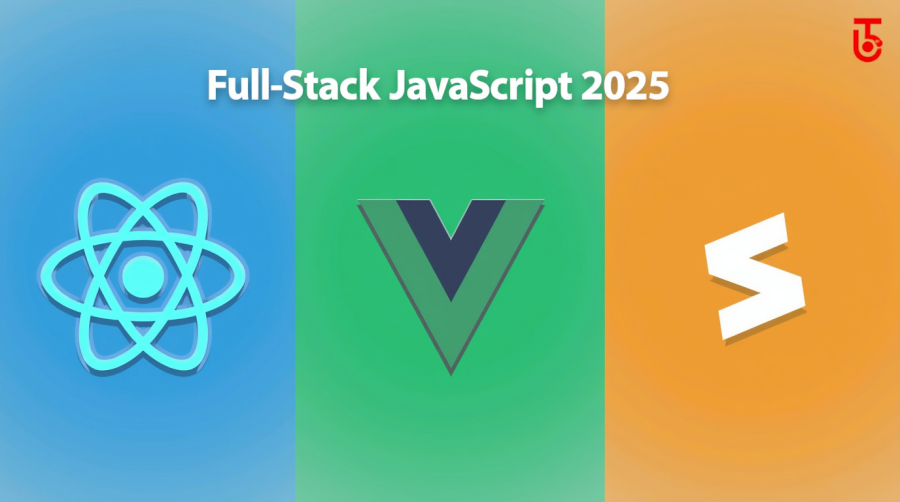Full-Stack JavaScript Frameworks 2025: Next.js vs Nuxt.js vs SvelteKit - The Complete Developer Guide
23 May 2025
Full-stack JavaScript frameworks have revolutionized modern web development, enabling developers to build complete applications with a single language. As we navigate 2025, Next.js, Nuxt.js, and SvelteKit stand as the leading solutions, each offering unique approaches to server-side rendering, static site generation, and full-stack development.
This comprehensive guide examines these three powerhouses, analyzing their performance, developer experience, and ideal use cases to help you choose the perfect framework for your next project.
The Rise of Full-Stack JavaScript Frameworks
Full-stack JavaScript frameworks address the complexity of modern web applications by providing unified solutions for both client and server-side development. They eliminate the traditional separation between frontend and backend, offering seamless integration of server-side rendering (SSR), static site generation (SSG), and API routes within a single framework.
The benefits are compelling: improved SEO through server-side rendering, better performance with optimized bundling, simplified deployment processes, and reduced context switching for developers working across the entire application stack.
Market Adoption and Developer Preferences 2025
The full-stack JavaScript landscape has matured significantly, with clear leaders emerging:
Next.js dominates with 65% market share among full-stack JavaScript frameworks, backed by Vercel's infrastructure and React's ecosystem. Its adoption spans from startups to Fortune 500 companies.
Nuxt.js holds 25% market share, particularly strong in Europe and among Vue.js developers. The framework has gained enterprise traction with its comprehensive feature set and excellent developer experience.
SvelteKit captures 10% market share but shows the fastest growth rate at 150% year-over-year. Developers praise its performance and innovative approach to full-stack development.
Next.js: The React Ecosystem Leader
Next.js has evolved from a simple React framework to a comprehensive full-stack platform, offering everything from static sites to complex web applications.
Core Strengths
App Router Architecture: Next.js 13 introduced the App Router, bringing React Server Components and improved data fetching patterns. This architecture enables better performance through selective hydration and reduced JavaScript bundles.
Deployment Ecosystem: Vercel's seamless deployment experience, combined with edge computing capabilities, makes Next.js applications globally fast and highly available. The platform's automatic optimization handles performance concerns without developer intervention.
Enterprise Features: Built-in authentication, internationalization, and middleware support make Next.js suitable for complex business applications. The framework's TypeScript integration and testing utilities support large development teams.
Performance Optimizations: Automatic image optimization, font optimization, and script loading strategies are built into the framework. Next.js applications consistently achieve high Lighthouse scores with minimal configuration.
Recent Improvements in 2025
The Next.js 14 and 15 releases have focused on developer experience and performance:
Turbopack Integration: The new bundler provides significantly faster build times, especially for large applications. Hot reloading now occurs in milliseconds rather than seconds.
Enhanced Server Actions: Simplified form handling and server-side mutations reduce boilerplate code while maintaining type safety.
Improved Caching: More granular caching controls allow developers to optimize performance for specific use cases.
Limitations and Considerations
Next.js applications can become complex quickly, especially when mixing different rendering strategies. The learning curve includes understanding React Server Components, caching strategies, and the App Router's file-based routing system.
Vendor Lock-in Concerns: While Next.js works on any Node.js platform, many features are optimized for Vercel's infrastructure, potentially creating deployment dependencies.
Bundle Size: React's overhead means Next.js applications typically have larger JavaScript bundles compared to SvelteKit alternatives.
Ideal Use Cases
Next.js excels in:
- E-commerce platforms requiring SEO and performance
- Enterprise applications with complex authentication needs
- Content management systems and blogs
- Applications requiring extensive third-party integrations
- Teams already invested in the React ecosystem
Nuxt.js: The Vue.js Full-Stack Solution
Nuxt.js provides a comprehensive full-stack framework built on Vue.js, offering powerful features with an emphasis on developer experience and convention over configuration.
Core Strengths
Auto-Import System: Nuxt.js automatically imports components, composables, and utilities, reducing boilerplate code and improving developer productivity. The system intelligently tree-shakes unused imports.
Module Ecosystem: Over 200 official and community modules extend Nuxt.js functionality, covering everything from authentication to analytics. Modules integrate seamlessly with minimal configuration.
Hybrid Rendering: Nuxt.js 3 introduced hybrid rendering, allowing different pages to use different rendering strategies (SSR, SSG, SPA) within the same application.
Developer Experience: Excellent DevTools, comprehensive documentation, and intuitive file-based routing make Nuxt.js approachable for developers of all skill levels.
Nuxt.js 3 Innovations
The latest major version represents a complete rewrite focusing on performance and modern development practices:
Nitro Engine: The new server engine provides universal deployment capabilities, supporting serverless, edge, and traditional hosting environments with a single codebase.
Composition API Integration: Full support for Vue 3's Composition API enables better code organization and TypeScript integration.
Vite Integration: Development builds are significantly faster thanks to Vite's optimized bundling and hot module replacement.
Performance Characteristics
Nuxt.js applications typically achieve excellent performance metrics:
Bundle Sizes: Efficient tree-shaking and automatic code splitting result in smaller JavaScript bundles compared to Next.js applications.
Loading Speed: Server-side rendering combined with intelligent preloading strategies delivers fast initial page loads.
SEO Optimization: Built-in meta tag management and structured data support ensure excellent search engine visibility.
Limitations
The Vue.js ecosystem, while comprehensive, is smaller than React's, potentially limiting third-party component options. Nuxt.js also has fewer hosting-specific optimizations compared to Next.js on Vercel.
Learning Curve: Developers unfamiliar with Vue.js need to learn both the framework and Nuxt.js conventions.
Ideal Use Cases
Nuxt.js is perfect for:
- Content-heavy websites and blogs
- E-commerce applications requiring fast loading
- Progressive web applications
- Projects prioritizing developer experience
- Teams with Vue.js expertise
SvelteKit: The Performance-First Framework
SvelteKit represents a new generation of full-stack frameworks, leveraging Svelte's compile-time optimizations to deliver exceptional performance with minimal complexity.
Revolutionary Approach
Compile-Time Optimization: SvelteKit generates highly optimized vanilla JavaScript, eliminating the runtime overhead associated with virtual DOM frameworks. This results in smaller bundles and faster execution.
Progressive Enhancement: The framework is built on web standards, ensuring applications work without JavaScript while enhancing functionality when available.
Minimal Configuration: SvelteKit requires minimal setup and configuration, allowing developers to focus on building features rather than managing tooling.
Technical Innovations
Adapter System: SvelteKit's adapter system enables deployment to any platform, from serverless functions to static hosting, with platform-specific optimizations.
Load Functions: Unified data loading for both server and client-side rendering eliminates the complexity of managing different data fetching strategies.
Form Actions: Built-in form handling with progressive enhancement provides excellent user experience without JavaScript dependencies.
Performance Advantages
SvelteKit consistently outperforms other full-stack frameworks in key metrics:
Bundle Size: Applications are typically 40-60% smaller than equivalent Next.js or Nuxt.js applications.
Runtime Performance: Compiled code executes faster with lower memory usage, particularly beneficial for complex interactions.
Time to Interactive: Minimal JavaScript overhead results in faster time to interactive, especially on slower devices.
Ecosystem Considerations
SvelteKit's ecosystem is rapidly growing but remains smaller than established alternatives:
Third-Party Libraries: Fewer Svelte-specific libraries are available, though most vanilla JavaScript libraries work seamlessly.
Tooling: Development tools are improving rapidly, with excellent VS Code support and growing community contributions.
Hosting Support: Major platforms now support SvelteKit, with adapters available for Vercel, Netlify, Cloudflare, and traditional hosting.
Limitations
The smaller ecosystem means fewer pre-built solutions and community resources. SvelteKit also represents a newer paradigm that may require learning new patterns and best practices.
Enterprise Adoption: Limited enterprise adoption means fewer case studies and established patterns for large-scale applications.
Ideal Use Cases
SvelteKit excels in:
- Performance-critical applications
- Content websites requiring fast loading
- Applications targeting slower devices or networks
- Projects prioritizing minimal JavaScript overhead
- Developer teams embracing cutting-edge technology
Feature-by-Feature Comparison
Server-Side Rendering (SSR)
Next.js: Comprehensive SSR with React Server Components, streaming, and partial hydration. Excellent for complex applications requiring dynamic content.
Nuxt.js: Robust SSR implementation with hybrid rendering options. Universal rendering works seamlessly across different deployment targets.
SvelteKit: Efficient SSR with minimal JavaScript overhead. Progressive enhancement ensures functionality without client-side JavaScript.
Static Site Generation (SSG)
Next.js: Powerful SSG with incremental static regeneration (ISR) for dynamic content. Excellent for large sites with frequently updated content.
Nuxt.js: Comprehensive SSG with automatic route generation and content management integration. Strong for content-heavy websites.
SvelteKit: Fast SSG with prerendering capabilities. Smaller static files result in faster loading times.
API Routes and Backend Integration
Next.js: Full-featured API routes with middleware support. Server Actions simplify form handling and server-side mutations.
Nuxt.js: Nitro-powered server API with universal deployment capabilities. Excellent for building full-stack applications.
SvelteKit: Streamlined API routes with TypeScript integration. Form actions provide excellent user experience patterns.
Developer Experience
Next.js: Comprehensive tooling with excellent TypeScript support. Large ecosystem provides solutions for most requirements.
Nuxt.js: Outstanding developer experience with auto-imports and comprehensive DevTools. Excellent documentation and community support.
SvelteKit: Minimal configuration with intuitive patterns. Fast development builds and excellent debugging experience.
Performance Optimization
Next.js: Automatic optimizations for images, fonts, and scripts. Extensive configuration options for performance tuning.
Nuxt.js: Built-in performance optimizations with module-based enhancements. Excellent Lighthouse scores out of the box.
SvelteKit: Superior performance through compilation. Minimal runtime overhead and smaller bundle sizes.
Deployment and Hosting Considerations
Deployment Flexibility
Next.js: Optimized for Vercel but works on any Node.js platform. Edge computing capabilities enhance global performance.
Nuxt.js: Universal deployment through Nitro engine. Supports serverless, edge, and traditional hosting environments.
SvelteKit: Adapter system supports all major platforms. Static generation works with any hosting provider.
Scaling and Performance
Next.js: Excellent scaling capabilities with CDN optimization and edge computing. ISR enables efficient updates for large sites.
Nuxt.js: Good scaling with caching strategies and CDN integration. Module ecosystem provides performance enhancements.
SvelteKit: Inherently performant with minimal server resources required. Excellent for cost-effective scaling.
Learning Curve and Skill Requirements
Beginner Friendliness
Nuxt.js offers the gentlest learning curve with excellent documentation and intuitive conventions. Developers familiar with Vue.js can become productive quickly.
SvelteKit provides a moderate learning curve with straightforward concepts and minimal configuration requirements.
Next.js has the steepest learning curve due to React's complexity and the framework's extensive feature set.
Advanced Features Mastery
All three frameworks require significant investment to master advanced features like caching strategies, performance optimization, and deployment configuration.
Job Market and Career Opportunities
Current Demand
Next.js dominates job postings with opportunities across all company sizes and industries. React expertise translates directly to Next.js opportunities.
Nuxt.js shows growing demand, particularly in agencies and companies using Vue.js. European markets show stronger adoption.
SvelteKit represents an emerging opportunity with limited but growing demand. Early adopters often find premium opportunities.
Salary Expectations
Next.js developers command competitive salaries across all experience levels. Nuxt.js developers earn similar wages in Vue.js-focused markets. SvelteKit expertise often commands premium rates due to scarcity.
Making the Right Choice
Choose Next.js When:
- Building complex enterprise applications
- Leveraging React ecosystem and team expertise
- Requiring extensive third-party integrations
- Planning deployment on Vercel or similar platforms
- Prioritizing job market opportunities
Choose Nuxt.js When:
- Developing content-heavy applications
- Working with Vue.js-experienced teams
- Requiring excellent developer experience
- Building progressive web applications
- Prioritizing convention over configuration
Choose SvelteKit When:
- Performance is the top priority
- Building content websites or blogs
- Working with performance-constrained environments
- Embracing cutting-edge technology
- Prioritizing minimal JavaScript overhead
Future Outlook and Trends
Next.js Evolution
Next.js continues expanding its full-stack capabilities with improved Server Components, better caching strategies, and enhanced edge computing features. The framework's integration with React's roadmap ensures continued innovation.
Nuxt.js Growth
Nuxt.js 4 development focuses on performance improvements and ecosystem expansion. The framework's universal deployment capabilities position it well for diverse hosting requirements.
SvelteKit Momentum
SvelteKit shows the strongest growth trajectory with increasing enterprise adoption and ecosystem development. The framework's performance advantages become more compelling as applications grow in complexity.
Best Practices and Recommendations
Regardless of your chosen framework, follow these best practices:
Performance First: Implement proper caching strategies, optimize images and fonts, and monitor Core Web Vitals regularly.
TypeScript Integration: Leverage TypeScript for better code quality and developer experience across all frameworks.
Testing Strategy: Implement comprehensive testing including unit tests, integration tests, and end-to-end testing.
Deployment Optimization: Configure proper CI/CD pipelines and monitoring for production applications.
Security Considerations: Follow security best practices for authentication, data validation, and API protection.
Conclusion
The choice between Next.js, Nuxt.js, and SvelteKit depends on your specific requirements, team expertise, and project constraints. Next.js offers the most comprehensive ecosystem and job opportunities, Nuxt.js provides excellent developer experience with Vue.js integration, and SvelteKit delivers superior performance with innovative approaches.
Consider your long-term maintenance requirements, team skills, and performance needs when making this decision. Each framework has evolved to excel in specific scenarios, and the right choice will serve your project well for years to come.
The full-stack JavaScript landscape continues evolving rapidly, with each framework pushing the boundaries of what's possible with modern web development. Stay informed about updates and emerging patterns to make the most of your chosen framework.


